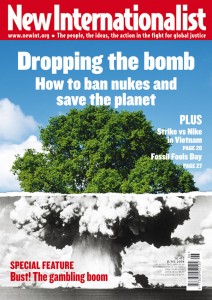With the death of former British Prime Minister Margaret Thatcher, the era of the Cold War seems more remote than ever. The Iron Lady was in her penultimate year of office when the Berlin Wall came down, and with it decades of the enveloping fear that at any moment a global nuclear exchange might end the world. That was nearly a quarter of a century ago. In that time, the existential threat posed by nuclear weapons has been almost entirely displaced by another. I speak, of course, of climate change, the great ‘inconvenient truth’ and ‘moral challenge’ of the times in which we find ourselves. Where once the emblematic colour of this fear was red, it is now green. An overarching sense of anxiety remains, with ecological catastrophe having replaced a hail of Soviet nuclear warheads as the principal nightmare.
We are, it hardly needs reiterating, correct to be fearful of the threat climate change poses to this generation and those that follow. The reality, however, is that the Sword of Damocles of nuclear warfare remains poised above us all, suspended by nothing more substantial than a few desultory international agreements. These agreements, as Geoffrey Robertson argues in his outstanding book Mullahs Without Mercy, will in all likelihood not prevent Iran, Saudi Arabia or even Egypt starting up their own nuclear arsenals in the near future. That’s to say nothing of a long-touted ‘African bomb’, or the possibility that terrorist groups could get their hands on fissile materials and missile hardware on a burgeoning black market. Any one of these eventualities could, at the minimum, result in hundreds of thousands of civilian deaths, widespread destruction of housing and infrastructure, and long-term environmental devastation. Let us not forget that as early as 1952, the United States was successfully testing thermonuclear devices over 500 times more powerful than the Hiroshima bomb. The B61 device, a keystone of the US’s current stockpile of around 5000 weapons, can have a yield as high as 340 kilotons – twenty times more powerful than Little Boy.
There is no doubt that Benjamin Netanyahu’s bizarre shadow play at the United Nations, and the recent antics of North Korea’s Supreme Leader, have succeeded in refocusing the world’s attention on the issue of nuclear weapons. We know, however, little about Tehran’s true progress in producing deployable weapons, and that at present no missile fired from Pyongyang is capable of hitting targets in the West. These are no red herrings – indeed, Geoffrey Robertson has argued that Kim Jong-un should be tried in the Hague for his threat to use a nuclear bomb alone – but the danger is hardly confined to the posturing and provocations of a couple of internationally reviled and isolated despots.
The vast bulk of the world’s nuclear arsenal – over 22,000 devices – is still in the possession of the United States and Russia. Many of these weapons can be readied and fired in minutes and, despite safeguards, the prospect of a nuclear exchange being triggered by computer or human error remains conceivable. So, too, does a nuclear exchange inaugurated not by a member of the ‘Axis of Evil’, but by a chief ally of the United States; despite its frequent excoriations of the nuclear ambitions of Iran and North Korea, the US tacitly approves of Israel’s undeclared stockpile of bombs, one or more of which may well be used in the not-too-distant future to pre-emptively attack Tehran.
The bottom line in all this is clear, doubly so in an era when the idea of nuclear deterrence has been leapfrogged by the realities of proliferation in the post-Cold War era: any number of nuclear weapons in the world is too many. It would be a cruel thing indeed if, amidst the bitter struggle to avert environmental catastrophe at the hands of climate change, we were wiped out by another existential menace, one that has been living with us for seventy years.
Other helpful resources:

